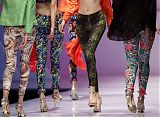Kim Yu-na is the reigning world champion. Mao Asada won the title the year before. Kim has won three of the last four Grand Prix finals. That other year? Asada.
This game of “Can you top this?” has been going on since the figure skaters were juniors. Although Kim has dominated this season while Asada has struggled, there’s little doubt the two will be at the center of the spotlight at the Vancouver Olympics.
If that scenario sounds a little familiar, well, it is. It was only about 18 months ago that Nastia Liukin and Shawn Johnson brought their two-woman show to the Beijing Games.
“I think we thrived off of each other,” said Liukin, who won the Olympic title while her U.S. teammate took silver. “It definitely brought out the best in both of us.”
Though neither competed last season, the two reunited in October for the “Skating and Gymnastics Spectacular” show, which will be shown Sunday on NBC.
“It was a lot of fun,” Johnson said of the show, which also features 2006 Olympian Emily Hughes and two-time Olympic silver medalist Elvis Stojko.
Although the sports barely resemble each other, figure skating and gymnastics share a common bond. They both combine art and athleticism, are subjective and have provided some of the most iconic moments of the Olympics. Women command the majority of attention.
They’re also glamour events, sports people watch and often find themselves talking about the next day. That there’s usually a big-name rivalry to spice things up — real or imagined, friendly or icy — only adds to the fun.
“I think we both knew, going into the Olympics, that there really wasn’t anyone we were too concerned about besides each other,” Liukin said.
Although Sasha Cohen, Irina Slutskaya and Sarah Hughes were all considered contenders for figure skating gold, you really have to go back to Tara and Michelle in ’98 for the last time there were two skaters clearly ahead of the pack.
Granted, Kim is the undisputed leader of that pack now. She has just two losses in two-plus seasons (the 2009 Grand Prix final and ’08 worlds), and opened this year by blowing away Asada — and everyone else — by 35 points at Trophee Eric Bompard.
Asada actually fell behind countrywoman Miki Ando, who was second to Kim at last month’s Grand Prix final, after a tough Grand Prix season. Asada didn’t even qualify for the Grand Prix final after finishing a distant fifth at the Rostelecom Cup.
But she appears to have gotten her mojo back, winning the Japanese nationals in commanding fashion.
“I hope that she skates up to it,” said Kim’s coach, Brian Orser, who knows a thing or two about rivalries as one of half of the “Battle of the Brians.” ‘‘These two girls have taken ladies figure skating to a whole new level, and it’s funny, because I feel that Boitano and I did that, too.
“Because of him, I got better. Because of Mao, Yu-na’s better and vice versa. They’re just better skaters because of each other,” Orser said. “And at the end of the day, they’ll be thanking each other for that.”
Unlike Asada and Kim, who is from South Korea, Liukin and Johnson were teammates. Though they trained at different gyms, they saw each other every month at national team training camps. No need to scour the Internet for scouting reports, they had first-hand looks at everything the other gymnast was doing.
The two combined to lead the U.S. women to the silver medal, then had to turn their attention to the individual competition. Not exactly easy when your main rival is also your friend — not to mention your roommate in the Olympic village.
But gymnastics and skating aren’t like skiing or swimming or track. There is no head-to-head competition, no clock to race. Asada and Kim will know the other is there — they’ll only be reminded a few thousand times — but Johnson said there’s only one person each woman can worry about: herself.
“Just make sure you’re thinking about yourself and knowing what you can do as a competitor. You can’t control what anyone else does,” Johnson said.
“It’s really hard to do,” she added. “You constantly want to watch and see who’s out there and what’s out there to beat. But that can psych you out. There’s nothing you can do. It’s only your routines, and your body.”
And try not to get caught up in the surroundings, Johnson said.
At least, not until the competition is over.
“It’s no different than any other competition you’ve ever competed in. But enjoy it,” said Johnson, who remembers “every second” of Beijing and cherishes the pictures she took there. “Take time to see things and meet people, because you’re in the company of the world’s greatest and you probably won’t be there again.”


